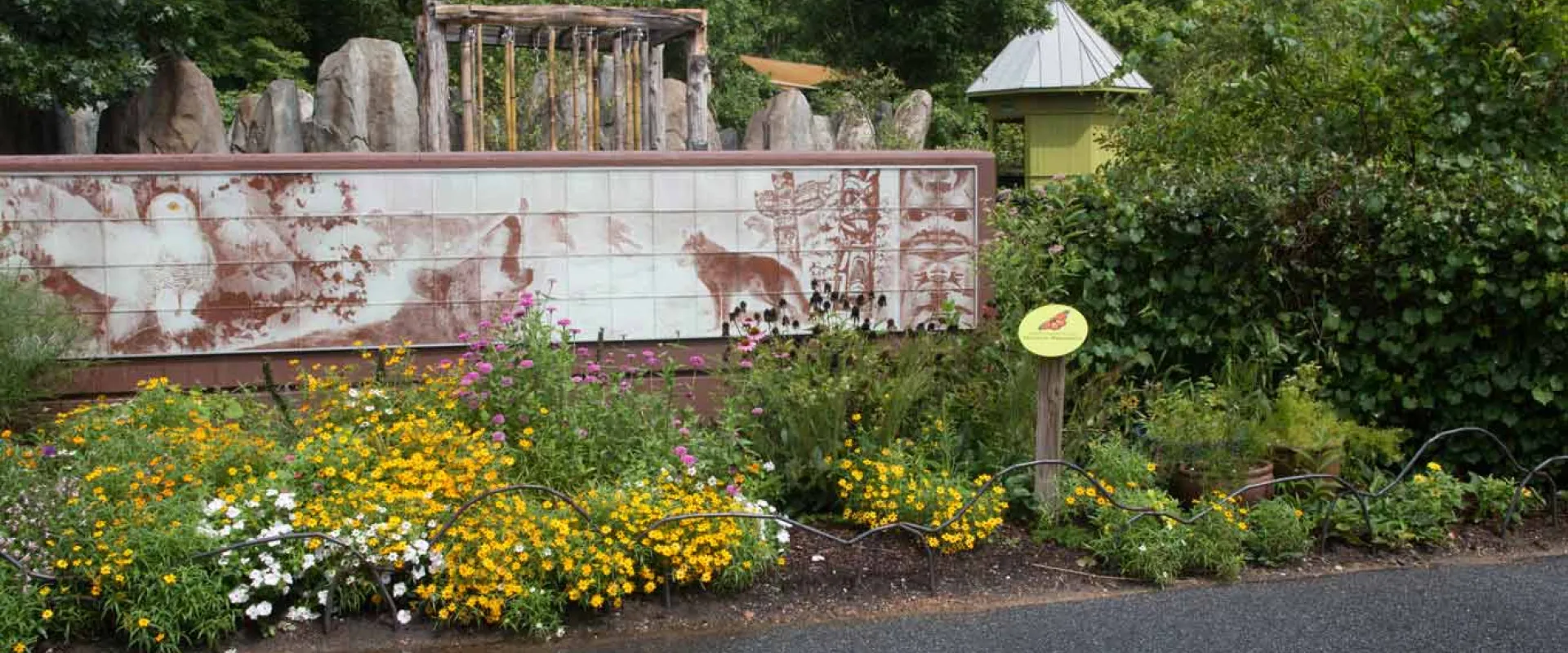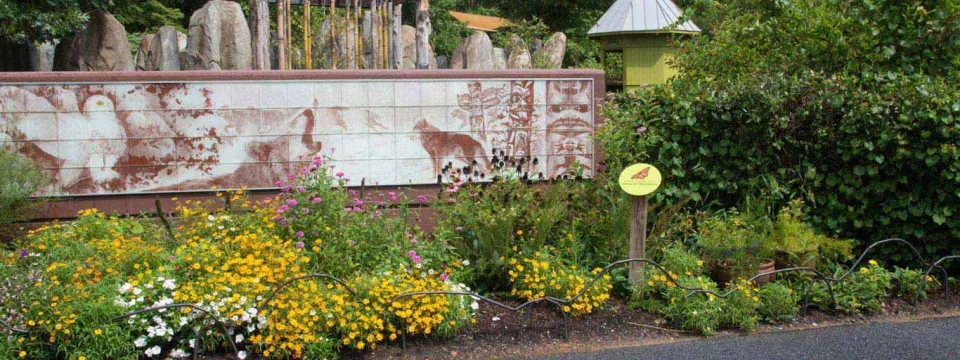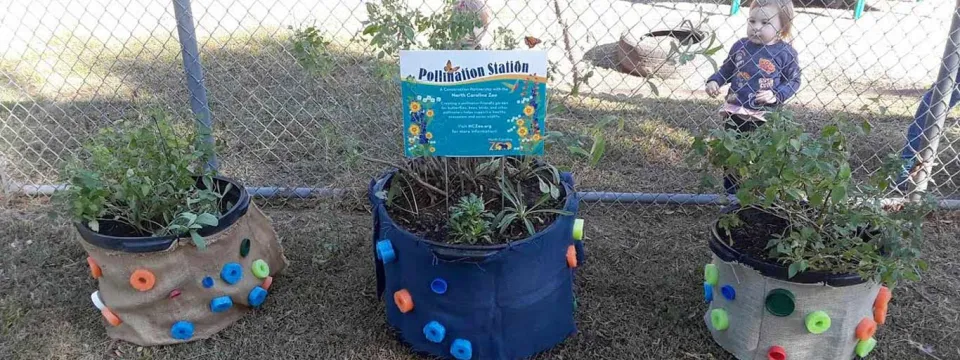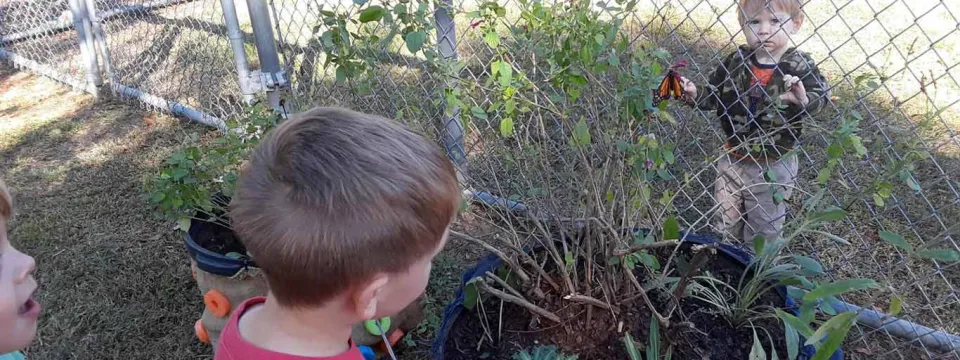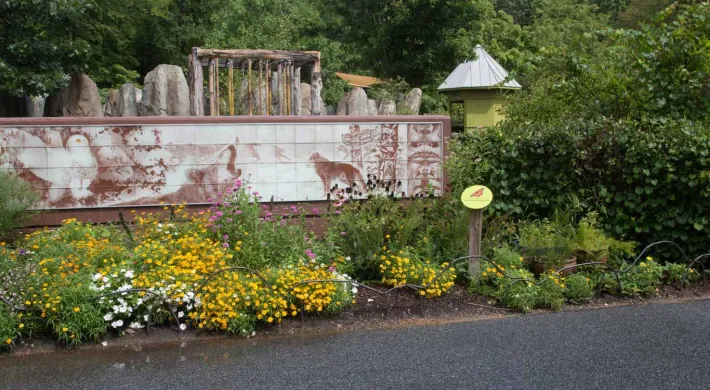Kathy Osborne, North Carolina Zoo's Kidzone Coordinator
Imagine traveling 2,000 miles from the North Carolina Zoo to the central highlands of Mexico. It would take you around 35 hours of driving in a car without any breaks. If you walked, it would take you more than 700 hours because you would have some steep inclines to reach your destination. Now, imagine doing that as a 3 ½ inch insect weighing a slight 3/100 of an ounce. That is what the monarch butterfly does to survive winter—it migrates. It makes this journey south every fall and spends the winter in the mountains located in central Mexico. They can fly between 50 to 100 miles a day but must stop and take shelter on cloudy, windy, or rainy days and at night. They get energy from the sun, but they need nectar for fuel. The closest thing to a fast-food restaurant for them is a “Pollination Station.”
Above image: Monarch Waystation at the North Carolina Zoo
The Zoo has been creating these Pollination Stations, or Monarch Waystations for years, but recently (starting in 2019) switched our focus to getting community members involved in creating Pollination Stations. Pollination Stations consist of three large planters of native nectar and host plants for local pollinator species (which includes the iconic monarch butterfly). Working with community partners, we have installed Pollination Stations at three Randolph County School’s preschool sites and one at the Child Development Center at Davidson County Community College.
We visit the schools and play a game where the children pretend to be monarch butterflies, and they fly from flower to flower to sip nectar. Each “flower” is identified by a toy or prop that illustrates its name. For example, a toy cardinal was used for the Cardinal Flower. By the end of the game, children as young as four years old could remember three of the flowers. “
Above image: Pollination Station at local school
Having the pollination station helps bring life to the outdoor learning environment for the children to explore. Children can investigate the plant life cycle and have hands-on experience of watching pollination in action. The pollination station helps spark a spirit of conservation in young children at an early age so that students can have positive experiences with nature and the outdoors,” said Dena Harward, one of the preschool teachers at Connie Redding Head Start in Randolph County.
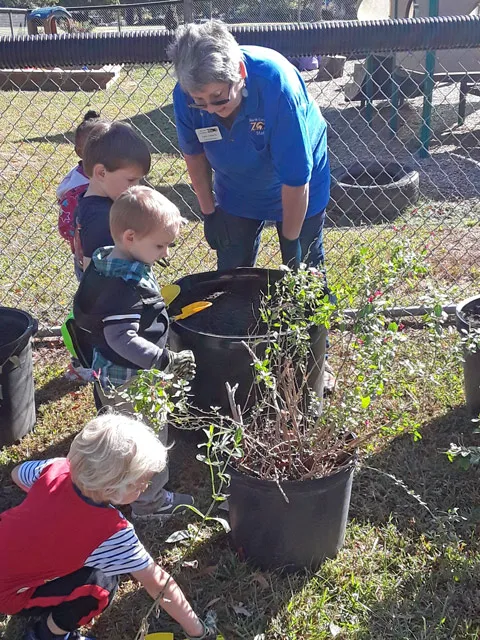
At the Child Development Center at Davidson County Community College, teachers took things one step further and raised monarch butterflies in the classrooms after setting up their Pollination Station. The children found out that monarch caterpillars can eat their way through a lot of milkweed! They had to put out a call for help among their families to supplement their supply of milkweed. Fortunately, one family had a good supply of common milkweed (Asclepius syriaca), so the caterpillars could finish their metamorphosis, which includes growing 2000 times their original size over about two weeks. The children watched the caterpillars make their chrysalis and then eclose (the proper term for coming out of the chrysalis). They were so excited to release the butterflies and watch them land on their Pollination Station.
Image Left: Kathy Osborne helps create next generation of gardening enthusiasts
“The Pollination Station provided to Davidson County Community College Child Development Center has been a great addition to our playground. We are currently working to develop a natural learning environment for our children. The Pollination Station has provided us with more plants and wildlife that the children thoroughly enjoyed watching grow and visit.
We are looking forward to adding to the Pollination Station this spring and cannot wait to see what kind of visitors we will have when everything begins to bloom. The Zoo introduces children to a more natural learning environment, and we could not be more grateful!” shared Program Director Whitney Parker.
Helping our pollinators is about more than teaching children about life cycles. It is showing them that they can make a difference. We cannot all travel to exotic locations to do conservation work, but we all can do something in our yards or patios. We can help pollinators. By providing native host plants and nectar plants, we help them, and they really need it.
Over the last two decades, monarch butterfly populations have dropped by 80%. Our other native pollinators are declining as well. That’s a big deal since one out of every three bites of our food needs animal pollinators. So, if four-year-old children can help, why can’t you?
We encourage Zoo guests to make Pollination Pods and start their own Pollination Station. What is a Pollination Pod? Basically, a seed bomb--a round, wet clump of dirt with seeds sprinkled in. And not just any seeds—sustainably sourced (no chemicals) native wildflowers and host plants. Toss your Pollination Pod in a sunny spot in your yard, garden, or planter. You will need to water it when it gets dry. Fall is a great time to plant the monarch’s host plant (the only plant that it will lay eggs on for its caterpillars to eat). If you live in North Carolina, you can choose several native milkweeds, the monarch’s host. Butterfly weed (Asclepias tuberosa) is the number one pollinator species according to the North Carolina Pollinator Conservation Alliance. You can find a Pollinator Toolkit by region visiting here online. Their website also lists where you can purchase plants and seeds. We made a video about how to make a Pollination Pod, you can watch it on Zoo's YouTube Channel.
If you can’t make your own, perhaps volunteer at the neighborhood school, park, or place of worship to create one. Planting and tending flowers is a great way to enjoy nature, relieve stress, and gardening with children is even better!
“That little planter provides a tiny percentage of an acre. It’s not a significant piece of land, but when placed between a beehive and a local vegetable garden, it might be priceless,” said Bob Langston, the Zoo’s Sustainability and Conservation Outreach Coordinator. Bob’s alter ego, the Neighborhood Naturalist, made a fun video about making your own Pollination Station out of a recycled plastic sandbox. You can watch it, as well, on the Zoo’s YouTube Channel.
Image below: Making a Pollination Station
